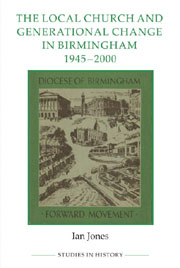Book contents
- Frontmatter
- Contents
- List of figures and tables
- Acknowledgements
- Abbreviations
- Map of Birmingham
- Introduction
- 1 Birmingham: the city and its churches
- 2 The spectre of ‘decline’
- 3 Church, youth and family from the 1940s to the 1960s
- 4 Life and worship in the local congregation
- 5 Church and neighbourhood: four congregational stories
- 6 Towards the margins: being Christian in a pluralist society
- Conclusion
- Appendix: Oral history
- Bibliography
- Index
5 - Church and neighbourhood: four congregational stories
Published online by Cambridge University Press: 05 February 2013
- Frontmatter
- Contents
- List of figures and tables
- Acknowledgements
- Abbreviations
- Map of Birmingham
- Introduction
- 1 Birmingham: the city and its churches
- 2 The spectre of ‘decline’
- 3 Church, youth and family from the 1940s to the 1960s
- 4 Life and worship in the local congregation
- 5 Church and neighbourhood: four congregational stories
- 6 Towards the margins: being Christian in a pluralist society
- Conclusion
- Appendix: Oral history
- Bibliography
- Index
Summary
The duality of ‘Church’ and ‘World’ is an inherent source of tension within Christianity, and was no less so in the late twentieth century as Christianity became a more distinct cultural constituency within English society. One particular aspect of this which has too often been overlooked in general histories of the period is the changing relationship between congregation and neighbourhood, a sphere of life through which wider trends were often most immediately experienced. Individual congregational stories are brought to the fore as lenses through which to explore the impact of three major changes in the life of postwar Birmingham which affected the city's religious life: the depopulation and redevelopment of the city's central area, the creation of new outer-ring suburbs and the ethnic diversification of many middle-ring neighbourhoods following the large-scale population migrations of the 1950s and 1960s. Yet these particular local issues also enable us to explore wider postwar developments in local church engagement with neighbourhoods through evangelistic mission, social action and the use of church buildings. Throughout, as a result of both wider community change and the ongoing rethinking of the mission of the local congregation, churchgoers of different ages brought with them, and sometimes acquired, different perspectives on how the Church should relate to its locality.
Urban areas had long been considered stony ground for the Churches. Against the traditional view that the Churches were slow to respond to urbanisation, many historians now make a more positive assessment of the concerted efforts made in the early nineteenth century to remedy the lack of religious provision in growing cities.
- Type
- Chapter
- Information
- Publisher: Boydell & BrewerPrint publication year: 2012



